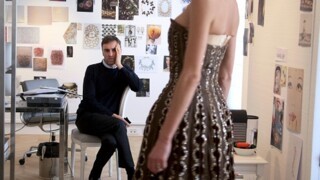‘Dior and I’
Fatema Ahmed
Dior and I, a documentary following Dior’s new creative director Raf Simons as he prepares his first haute couture collection(autumn-winter 2012), tries to summon up the fashion house’s ghosts while ignoring several elephants in the room. The film, which takes its name from Christian Dior’s 1956 autobiography,is careful to mention the French couturier at every turn (could it be a contractual condition?). But the recitation of passages from Dior’s book, in which he talks of the distance between hisprivate self and his public image, and clips of archive film, are a solemn distraction from the main event.
We first see Simons on the day he meets the atelier staff. He trained in furniture and industrial design before specialising in menswear and ready-to-wear. Having never worked with haute couture,he has only two months to design and produce his first collection. His right-hand man, Pieter Mulier, explains that 'Raf doesn't sketch', so we see lots of mood boards pinned up in the studio andhunched design staff drawing their master's visions. (‘Ateliers are the decoders of hieroglyphs,’ Dior wrote.)
Raf doesn’t cut or sew, either, but Dior’s ranks of petites mains in white lab coats can make anything. The two premières (the head of suiting and the head of soft dressmaking) direct the atelierin the business of making clothes for their regular clients, while Simons looks around for inspiration. In one scene he's gazing at Gerhard Richter’s 1970s abstracts in the Pompidou Centre andbuying monographs; in the next he has decided to recreate Sterling Ruby's more obviously appealing spray-paintings in fabric.
The formality at 30 Avenue Montaigne puzzles Simons, who wants to be called Raf. 'In couture,’ Dior's chief executive explains, ‘we say Monsieur.’ Language barriers are everywhere. Simons, aFlemish-speaking Belgian, quickly switches to fluent English. The head of tailoring is an Italian who speaks no French and needs an interpreter.
The economics of haute couture also seem mysterious to Simons, who can't understand why, on the day of his first view of the dress toiles (prototypes of the designs in cheap material), the atelierhead has flown out to see a client. ‘When a woman orders 350,000 euros each season,’ Catherine Rivière, the director of haute couture, explains to camera, ‘I won’t say no if she requests afitting.’
The documentary’s finale takes place behind the scenes at the catwalk show in July 2012. Simons takes the bow he has been saying all along that he won’t. The story has two big weaknesses: unduereverence for the New Look of 1947, and ignoring John Galliano’s departure in disgrace in 2011.
Frédéric Tcheng, the director of Dior and I, was a co-director of The Eye Has to Travel, about Diana Vreeland. Vreeland understood that women after the war were ‘starved forluxury’ but, unlike the fashion editors euphoric at being in Paris for the first time since 1939, saw the New Look as the regressive, corseted move that it was – ‘I always call it the guinea-henlook’ – undoing her championing of freer styles for women (think Lauren Bacall, photographed by Louise Dahl-Wolfe, on the cover of Harper’s Bazaar in 1943).
The most prominent items in Simons’s much-praised first collection were versions of Dior’s Barjacket (narrow waist, padded hips) and of his strapless, backless dresses (narrow waist, flaring out at the hips), with added pockets. It’s a safe, pretty collection that brilliantly recyclesand updates the past, and it was a great hit. But it makes the workers in the Dior atelier in their lab coats – yesterday’s vision of the future – look like a breath of fresh air.

